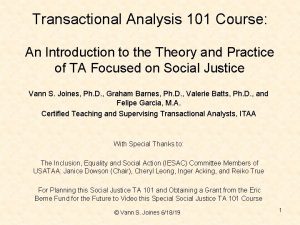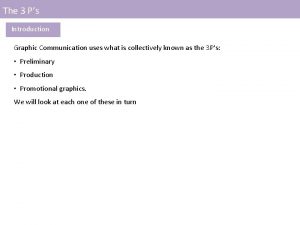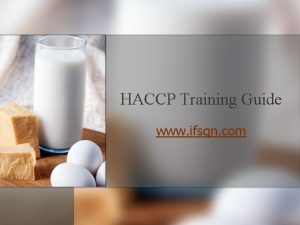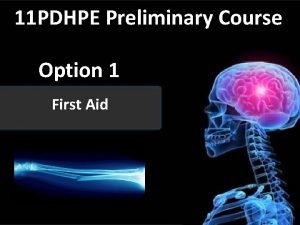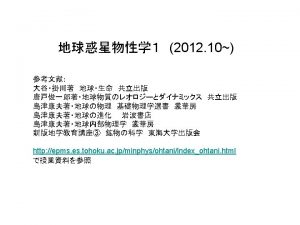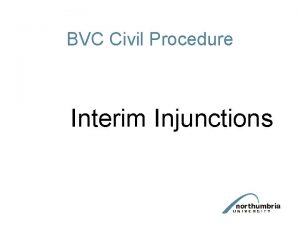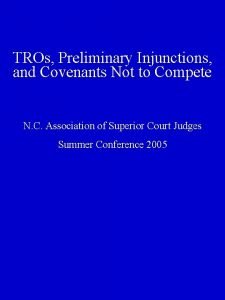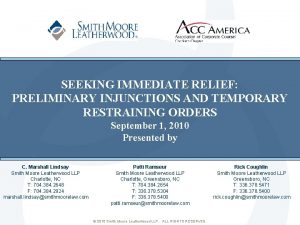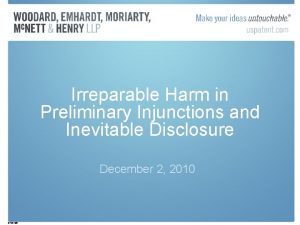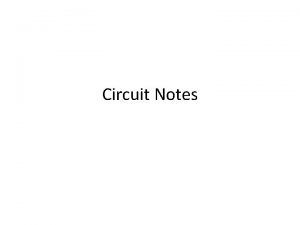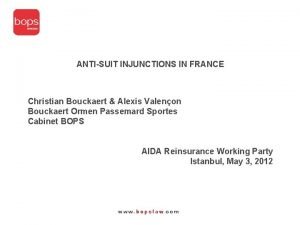Preliminary Injunctions in the 9 th Circuit When














- Slides: 14

Preliminary Injunctions in the 9 th Circuit – When Is Harm Irreparable? 27 th Annual Endangered Species Act Conference January 24, 2020 Chris Carr CONFIDENTIAL © Copyright Baker Botts 2018. All Rights Reserved.

The Winter Standard • Winter v. Natural Resources Defense Council, 555 U. S. 7 (2008) • A preliminary injunction is an “extraordinary remedy that may only be awarded upon a clear showing that the plaintiff is entitled to such relief. ” 555 U. S. at 22. • A plaintiff seeking a preliminary injunction must show: – (1) that he is likely to succeed on the merits; – (2) that he is likely to suffer irreparable harm in the absence of the relief requested; – (3) that the balance of equities tips in his favor; and – (4) that an injunction is in the public interest. 555 U. S. at 20. BAKER BOTTS 2

Standing and the Statute • Article III Standing – Injury-in-fact/harm; – Causation; and – Redressability • ESA Section 7 - “consultation process” and “jeopardy” standard – Bi. Op/ITS • ESA Section 9 - “take” prohibition • ESA Section 10 – HCP/ITP BAKER BOTTS 3

The “Denominator Problem” • (In)famous in 5 th Amendment Takings jurisprudence – “Regulatory taking” requires total “wipeout” or diminution in all economic value – Government commonly says “only 9/10 th of your land can’t be developed so there is no regulatory taking” – Incentivizes gaming around what is the “parcel as a whole” because that is the takings “denominator” • “Denominator” in ESA PI cases – For “irreparable harm” is it: • The population of the species as a whole? • Individual animal? • Something in between? – The “New Denominator Problem” BAKER BOTTS 4

E. D. Cal. and N. D. Cal. ESA PI Victories • Wanger Cases re USFWS Delta Smelt Bi. Op and NMFS Salmonid Bi. Op, 2009 -15 (E. D. Cal. ) [Section 7 cases] – Water suppliers and ag challenged 2009 Smelt and Salmonid Bi. Ops – Plaintiffs’ PI motions for more water for ag and cities granted – Plaintiffs made PI hearings “science trials” • Party and court expert Ph. D. s – Question before Judge Wanger in PI hearings: How many smelt could be entrained by the pumps before the smelt population would be jeopardized? – Smelt Bi. Op purported to quantify population-level effects on smelt, but Plaintiffs showed that FWS only identified # of smelt entrained in pumps, rather than % of smelt population entrained each year – 9 th Circuit reversed summary judgment orders invalidating Bi. Ops because the district court had based its decisions on scientific and technical evidence not in the Administrative Record – no effect on PI rulings/standard BAKER BOTTS 5

E. D. Cal. and N. D. Cal. ESA PI Victories • Wild Equity Institute, et al. v. City and County of San Francisco, et al. , 3: 11 -cv-00958 -SI (N. D. Cal. 2011) [Judge Illston] – Section 9 Case – Sharp Park Golf Course in Pacifica, California is a historic public “links” course separated by a seawall from the Pacific Ocean – Ponding/flooding in low area creates habitat for California red-legged frog (CRLF) – CRLF laid tens of thousands of eggs in artificial pond in “egg balls” each year – San Francisco Public Golf Alliance (SFPGA) intervened to defend golf course – WEI, CBD, Sierra Club sought PI closing “only” 10 holes of the golf course – SFPGA retained Dr. Mark Jennings – the pre-eminent CRLF expert in the country (co-author of listing petition) – to submit declaration in opposition to PI motion – Jennings’ declaration evaluated impact of egg desiccation on CRLF population – SFPGA only argued failure to show irreparable harm in its Opposition brief – Judge Illston (citing Dr. Jennings’ declaration) denied PI request, finding Plaintiffs failed to show “irreparable harm” to frog BAKER BOTTS 6

E. D. Cal. and N. D. Cal. ESA PI Victories • Defenders of Wildlife, et al. v. U. S. Fish and Wildlife Service, et al. , 5: 16 cv-01993 LHK (N. D. Cal. 2016) [Judge Koh] – Section 7 Case – 250 -MW solar PV project in San Benito County, California – Panoche Valley Solar intervened to defend approvals – Bi. Op for Giant kangaroo rat, Blunt-nosed leopard lizard, San Joaquin kit fox, and California tiger salamander – Corps issued 404 Individual Permit and FEIS – Plaintiffs alleged ESA Section 7 and CWA Section 404 violations – Plaintiffs filed PI to stop construction shortly after it had commenced – PVS retained leading experts on the species who submitted declarations concluding that project did not threaten any species at the population level – Judge Koh denied PI request, finding Plaintiffs failed to show likelihood of success on the merits (did not reach irreparable harm issue) BAKER BOTTS 7

Recent 9 th Circuit ESA PI Decisions • Cascadia Wildlands, et al. v. Scott Timber Co. , et al. , 2017 WL 5493908 (Nov. 16, 2017) [9 th Circuit] (Mem. Disp. ) – Section 9 Case – Plaintiffs moved for PI to stop timber harvesting, alleging likely take of a Ma. Mu pair occupying the “Benson Ridge parcel” – Parties created “battle of the experts” (no feds), including species presence – Judge Aiken (D. Or. ) granted PI, finding that Plaintiffs would be irreparably harmed if they could not observe the Ma. Mu pair in the Benson Ridge parcel – 9 th Circuit held: “In its approach to evaluating irreparable harm, the district court correctly required harm to Cascadia’s interest in individual members of the marbled murrelet species as opposed to harm to the entire species itself. ” – 9 th Circuit held the line on Winter’s requirement that irreparable harm to species be “likely” (in a case where Ma. Mu presence was in question) – But also held that Ma. Mu pair was the “denominator” BAKER BOTTS 8

Recent 9 th Circuit ESA PI Decisions • National Wildlife Federation, et al. v. National Marine Fisheries Service, et al. , 886 F. 3 d 803 (9 th Cir. 2018) – Section 7 Case – Long-running dispute over Federal Columbia River Power System’s (FCRPS) impact on listed salmon and steelhead (Bi. Op challenged in 2000) – Judge Simon (D. Or. ) granted a permanent injunction requiring increased spill, while holding Plaintiffs were not required to show “an imminent threat at the species level” – 9 th Circuit applied the irreparable harm standard for a PI (from Winter) because the district court characterized the relief it ordered during the remand period as “interim injunctive measures” pending issuance of a new Bi. Op – 9 th Circuit held: “Thus, the district court was not required to find a short-term extinction-level threat to listed species in order to find likely irreparable harm for purposes of an ESA injunction. It was not legal error or an abuse of discretion to base the injunction on a finding of a lesser-magnitude of harm. ” – But it did not hold that a district court in an ESA case is required to find irreparable harm upon such a lesser showing of harm. BAKER BOTTS 9

Post NWF v. NMFS (9 th Cir. , April 2018) Decisions • Klamath Tribes v U. S. Bureau of Reclamation, 2018 WL 3570865 (N. D. Cal. , July 25, 2018): Section 7 suit re lake levels for sucker fish; PI denied. • Crow Indian Tribe v. U. S. , 2018 WL 41415908 (D. Montana, Aug. 30, 2018): Section 4 grizzly bear delisting suit; TRO granted. • Wishtoyo Foundation v. United Water Conservation District, 2018 WL 6265099 (C. D. Cal. , Sept. 23, 2018): Section 9 suit re take of steelhead; permanent injunction granted. • Northwest Environmental Defense Center v. U. S. Army Corps of Engineers, 2019 WL 2372591 (D. Oregon, June 5, 2019): Section 7 suit re Willamette River dam operations on steelhead and chinook; PI denied. • Wildearth Guardians v. U. S. Fish and Wildlife Service, 2019 WL 4345333 (D. Arizona, Sept. 12 2019): Section 7 suit re USFS forest program activities on Mexican Spotted Owl; permanent injunction granted. BAKER BOTTS 10

“Lean in” to PI standard before the district courts in the 9 th Circuit • Navigate tension between Article III standing harm and PI irreparable harm – Challenging standing can drive plaintiffs (and court) to a smaller denominator, as plaintiff tries to show its “interest” in or use of the species • Don’t tell the district court judge his or her equitable discretion in assessing the likelihood of irreparable harm is constrained by the ESA because harm must be evaluated at the population-level (i. e. , the denominator must be a population-level #) – District court judges sitting in equity don’t like to be told what they can’t do – Avoid 9 th Circuit categorical ruling that the ESA dictates the take of one animal (or its egg) is irreparable harm as a matter of law • Load up on expert(s) at PI stage (don’t wait for merits/permanent injunction) – Plaintiffs usually win by delay – Engage eminence gris expert(s) • Quantitative/population dynamics modeling • Qualitative/biology and habitat BAKER BOTTS 11

“Lean in” to PI standard before the district courts in the 9 th Circuit • Characterize the relevant population of the species – Historic range, current range/population, regional population, some other subpopulation? – Should the “denominator” differ by species? • Charismatic species problem • Trophic place/role • Biology and life cycle (mobility, habitat availability, fecundity, longevity, etc. ) – Should the “denominator” differ by the plaintiff’s asserted “interest” • Could Plaintiff’s “interest” in one CRLF egg ball make it the “denominator” for irreparable harm analysis? • Could Plaintiff’s “interest” in one Ma. Mu pair make it the “denominator” for irreparable harm analysis? • • • Navigate tension between Article III standing harm and PI irreparable harm. Helping USFWS or NMFS in a section 7 case with experts Soliciting DOJ amicus participation in district court in section 9 case BAKER BOTTS 12

Questions? • Please contact: Chris Carr Baker Botts LLP 101 California Street San Francisco, CA 94111 • E-mail: chris. carr@bakerbotts. com • Telephone: 415 -291 -6208 BAKER BOTTS 13

AUSTIN BEIJING BRUSSELS DALLAS DUBAI HONG KONG HOUSTON LONDON MOSCOW NEW YORK PALO ALTO RIYADH SAN FRANCISCO WASHINGTON bakerbotts. com ©Baker Botts L. L. P. , 2018. Unauthorized use and/or duplication of this material without express and written permission from Baker Botts L. L. P. is strictly prohibited. Excerpts and links may be used, provided that full and clear credit is given with appropriate and specific direction to the original content.
 Transactional analysis 101
Transactional analysis 101 Different types of circuits
Different types of circuits Short circuit circuit diagram
Short circuit circuit diagram Circuit construction kit
Circuit construction kit Venn diagram of active and passive voice
Venn diagram of active and passive voice Parallel circuit vs series circuit
Parallel circuit vs series circuit The circulatory system
The circulatory system Disadvantages of a parallel circuit
Disadvantages of a parallel circuit What are complete and incomplete circuits
What are complete and incomplete circuits Current in a parallel circuit
Current in a parallel circuit 3 p's graphic communication
3 p's graphic communication Reading pet part 2
Reading pet part 2 Preliminary steps of haccp
Preliminary steps of haccp Pdhpe first aid
Pdhpe first aid P 波
P 波
